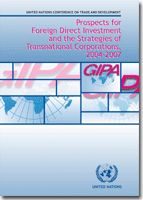
Prospects for global foreign direct investment (FDI) are expected to be positive in both the short term (2004-2005) and the medium term (2006-2007). The extent and the speed of the FDI recovery, however, will vary by region and industry. Despite the FDI recovery, competition for FDI is expected to become fierce in the years to come.
The stage for the expected FDI recovery is set by the acceleration of global GDP growth, the relatively low levels of interest rates in major capital exporting economies, and the increase in domestic investment and industrial output. Corporate profits of TNCs are also rising, as are stock valuations. All groups surveyed by UNCTAD agreed that investment confidence is returning and that global FDI flows are likely to increase during the period 2004-2007.
Services are expected to be the sector most attractive to FDI, particularly in tourism, telecommunications and IT. Prospects for manufacturing are also expected to be good, although varying by industry. Electronics, automobiles and machinery are expected to perform better. The primary sector is expected to see a moderate FDI recovery.
Asia and Central and Eastern Europe are viewed as the most attractive regions for FDI, while relatively weaker FDI recovery is expected in Western Europe and Africa in 2004-2005, and in Latin America in 2006-2007. The top FDI recipients for 2004-2005 are likely to be China and India in Asia, South Africa and Egypt in Africa, Brazil and Mexico in Latin America and the Caribbean, Poland and Russia in Central and Eastern Europe, and the United States and the United Kingdom among the industrialized countries.
The United States, the United Kingdom, France, Germany and Japan will continue to be the main sources of FDI, but newcomers such as China and South Africa will also be on the list of top FDI providers.
Mergers and acquisitions are expected to resume their popularity in developed economies, while greenfield investments will be preferred in developing countries.
The surge in offshoring worldwide indicates that lower-labour-cost countries will benefit most from FDI, in activities such as production, logistics and support and sales & marketing. Infrastructure and skill-dependent investments will also expand in certain countries.
Policy competition for FDI is getting fierce. Most host countries are expected to intensify their efforts in investment targeting, in addition to offering more generous investment incentives and further liberalization.
These generally positive trends may be counterbalanced by a number of risk factors, including oil price volatility, the rise of new protectionism impeding trade and outward FDI, regional conflicts and increased threats from terrorism. Also on the down side, some major developed and developing countries continue to struggle with structural impediments to economic growth and FDI flows.
Overall, the positive factors will outweigh the negative ones, although the recovery will be modest when compared to the 1999-2000 FDI boom driven by massive M&A deals.


